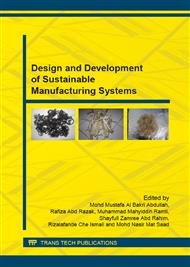p.84
p.89
p.94
p.101
p.106
p.111
p.116
p.121
p.131
Effect of Alkali Treatment Using Calcium Hydroxide and the Fiber Length on the Strength of Sugarcane Bagasse Fibers-Polypropylene Composites
Abstract:
Milling sugarcanes to produce sugar generates by-product called bagasse. Due to the large availability and low cost, the potential of obtaining renewable and biodegradable fibers from bagasse had been explored. To produce fibers from these bagasse, the bagasse was treated in alkali solution using 14 % v/v calcium hydroxide, Ca (OH)2 at high temperature (60-70°C) for 4 hours. After treatment and washed to remove dissolved substances, the fibers were cut into 3 and 5 cm length. Some fibers were prepared in their original length. These fibers were mixed with polypropylene (PP) matrix in weight % ratios of bagasse fibers/PP 20/80, 25/75, and 30/70 and hotpressed to make composite samples. Composites produced were characterised with tensile test to evaluate their tensile properties. Scanning electron microscopy (SEM) was performed on the fiber surface as well as on the fracture area of the tensile tested samples. Tensile strength of the composite shows an increase with the increase of the fiber length and weight % ratios of bagasse fibers/PP up to 25/75 and decreases when bagasse fibers were added to 30 wt.%. The highest strength of 11,30 MPa was obtained when 5 cm fibers were used in a weight % ratio of bagasse fibers/PP at 25/75. SEM study found a greater number of fibers oriented perpendicular to the tension direction.
Info:
Periodical:
Pages:
106-110
Citation:
Online since:
November 2015
Price:
Сopyright:
© 2015 Trans Tech Publications Ltd. All Rights Reserved
Share:
Citation:


